Menus
- New oldies in comparison
- Yamaha SR 400 more refined and easy to turn
- Both machines find their way into corners with ease
- Royal Enfield Continental GT with higher quality parts
- Sales prices difficult to justify
- Data and measured values
- MOTORCYCLE conclusion

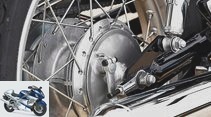
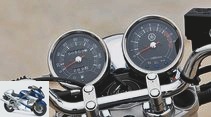

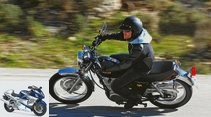
31 photos
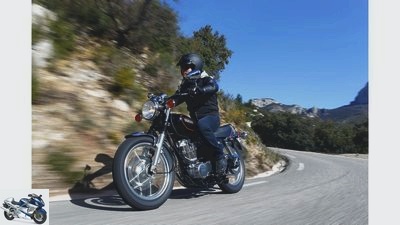
1/31
Royal Enfield Continental GT and Yamaha SR 400 in comparison test.
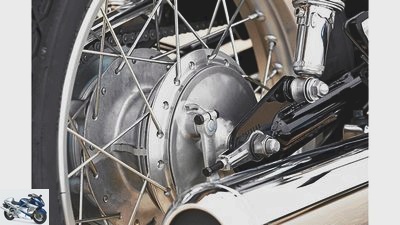
2/31
The rear half-hub drum brake is another relic from bygone motorcycle times – but a brand new one.
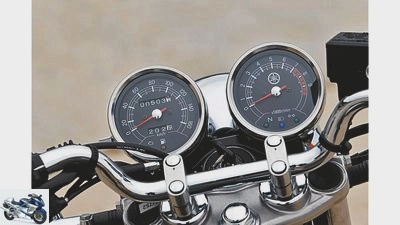
3/31
Stylish thanks to a lot of chrome, comfortable thanks to the rubber mounts on the handlebars, wonderfully old-fashioned thanks to mechanical instruments.
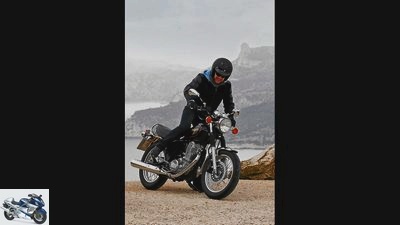
4/31
Royal Enfield Continental GT and Yamaha SR 400 in comparison test.
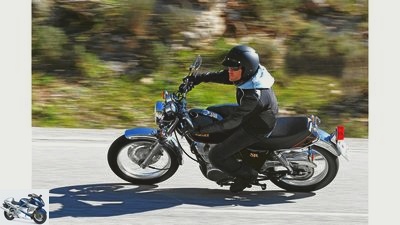
5/31
Wherever you can look, you can drive there. The SR 400 turns so easily that the driver can always choose any line.
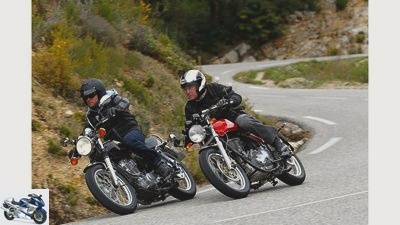
6/31
Royal Enfield Continental GT and Yamaha SR 400 in comparison test.
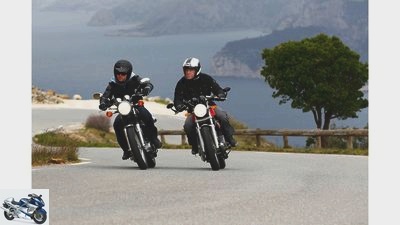
7/31
On good roads, the softly tuned and gently damped spring elements of both machines also work out bumps cleanly.
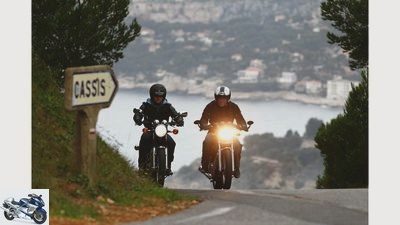
8/31
Royal Enfield Continental GT and Yamaha SR 400 in comparison test.
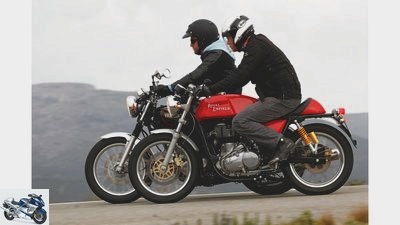
9/31
Royal Enfield Continental GT and Yamaha SR 400 in comparison test.
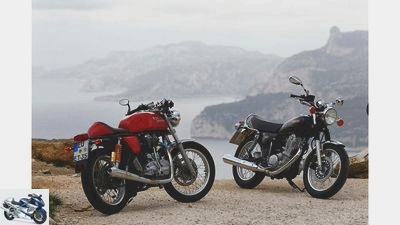
10/31
Royal Enfield Continental GT and Yamaha SR 400 in comparison test.
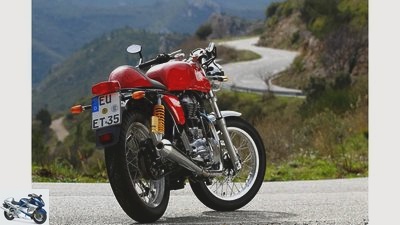
11/31
Royal Enfield Continental GT and Yamaha SR 400 in comparison test.
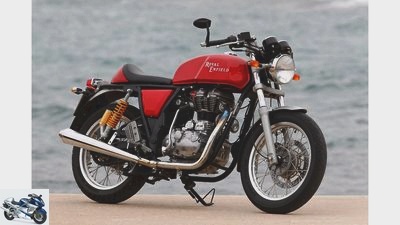
12/31
Royal Enfield Continental GT and Yamaha SR 400 in comparison test.
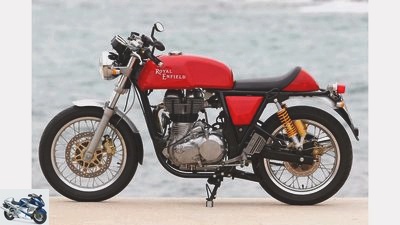
13/31
Royal Enfield Continental GT and Yamaha SR 400 in comparison test.
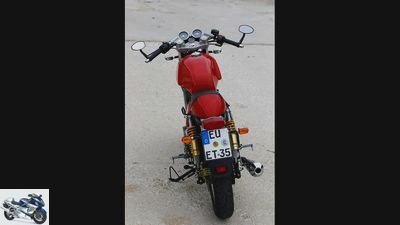
14/31
Royal Enfield Continental GT and Yamaha SR 400 in comparison test.
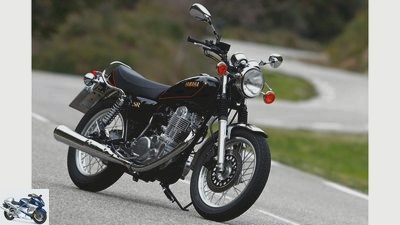
15/31
Royal Enfield Continental GT and Yamaha SR 400 in comparison test.
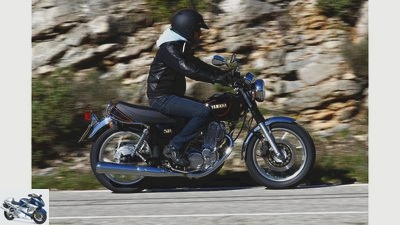
16/31
Royal Enfield Continental GT and Yamaha SR 400 in comparison test.
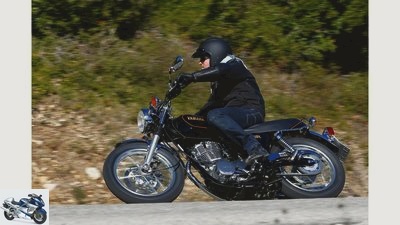
17/31
Royal Enfield Continental GT and Yamaha SR 400 in comparison test.
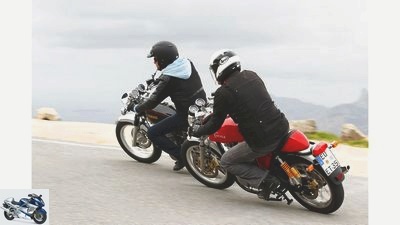
18/31
As traditional as the two motorcycles appear, the braking style of the pilots can be just as traditional.
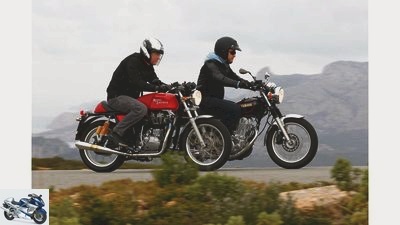
19/31
Rationally speaking, both motorcycles find it difficult to justify their sales prices.
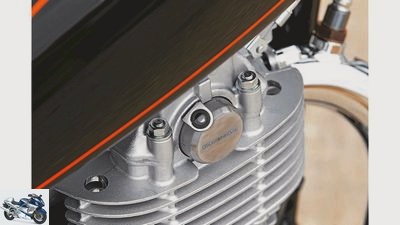
20/31
Correctly positioned: If you have it out, you can also compete in the referee without seeing the marking in the window.

21/31
Lovingly designed details at the rear: badge, lines on the seat edge and an elegantly curved chrome bar.
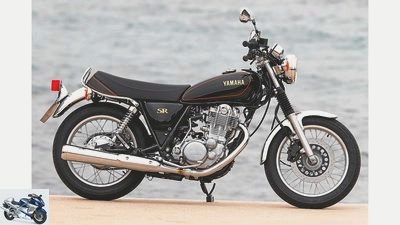
22/31
Not a racer, but a normal, slim and light motorcycle. This is how the SR 400 has presented itself for over 30 years.
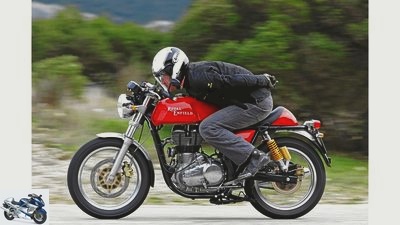
23/31
An aerodynamically optimized sitting and arm posture helps when chasing the last tenths of a km / h. If you don’t reach it, it doesn’t matter.
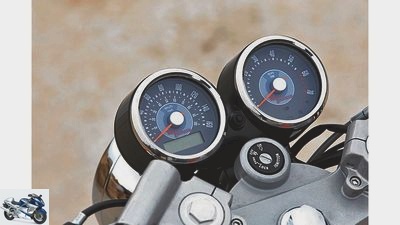
24/31
The speedometer works purely mechanically, all other displays are electronic-digital.
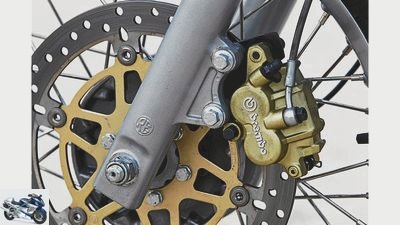
25/31
Neat, very matter-of-fact finish: powder-coated fork sliding tubes, tough screws. The wheel axle should be a little shorter.
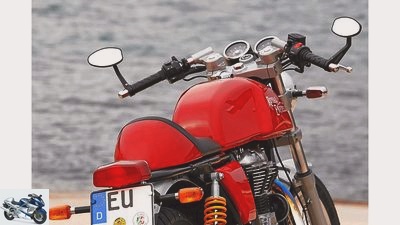
26/31
The tank, seat and hump impress with their classically elegant sportiness. The upper triple clamp and the attached handlebar halves look a bit rough.
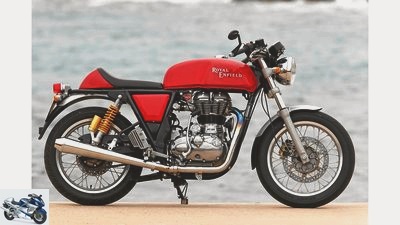
27/31
A real motorbike: the mighty single-cylinder dominates the side view of the GT.
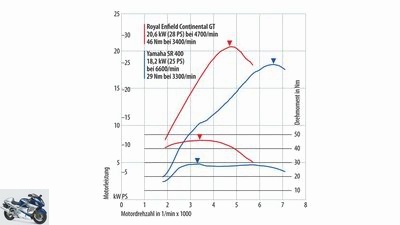
28/31
These two curves could also illustrate the properties of long and short stroke cylinders in a textbook for engine technology.
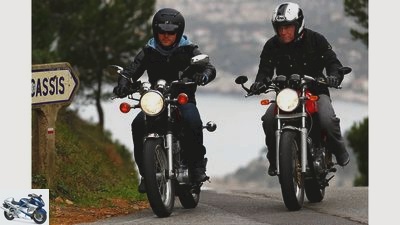
29/31
Royal Enfield Continental GT and Yamaha SR 400 in comparison test.
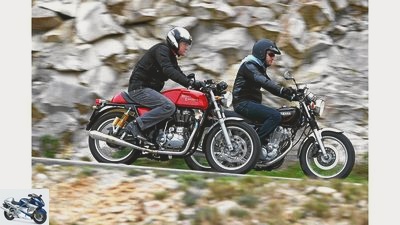
30/31
Royal Enfield Continental GT and Yamaha SR 400 in comparison test.
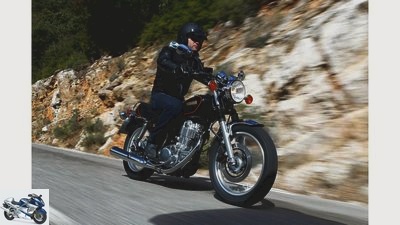
31/31
The Yamaha SR 400 is 13 kilograms lighter than the Royal Enfield Continental GT.
Royal Enfield Continental GT and Yamaha SR 400 in the test
New oldies in comparison
The Yamaha SR 400 has been built almost unchanged since 1978. Now she’s coming to Europe. Here she is already expected by the Royal Enfield Continental GT, a cafe racer from India. Two new motorcycles with the flair of the 70s in the test.
After all these years the procedure is still the same: pull the valve lifter, slowly turn the crankshaft via the kick starter until the silver marking appears in the camshaft’s window. Then let go of the valve lifter and give the starter a firm kick downwards. The Yamaha SR 400 still doesn’t like doing things by halves; if the driver steps too laxly, the solid starter lever pulls back. No doubt it’s not a retro bike, it’s the original. Thanks to injection, the Yamaha jumps S.R 400, however, immediately takes every convincing step, regardless of whether it is cold, undercooked or hot. And falls into a stable idle state. And the Royal Enfield Continental GT?
Buy complete article
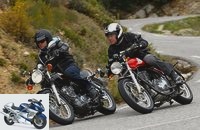
Royal Enfield Continental GT and Yamaha SR 400 in the test
New oldies in comparison
Continental GT rule. It is an expressive motorcycle; This applies not only to the exhaust sound of your 535 single-cylinder, but also to its mechanical sound development and the vibrations that make it bounce around in its rubber mounts for sheer energy.
Yamaha SR 400 more refined and easy to turn
The Yamaha SR 400 holds back elegantly. Almost too posh, their exhaust sound could easily be stronger. The extremely subtle mechanical noises speak for the high precision of the manufacturing at Yamaha. Thanks to the smaller displacement achieved by the shorter stroke, the 400 series runs more refined than the 500 series SR engine and is also more revving. The SR 400-Single is more maneuverable than the long-stroke, large-volume Enfield single-cylinder with pushrod valve train. In return, the Royal Enfield Continental GT keeps its nose ahead in daily driving practice and also during test drives. It owes this mainly to its ample torque. It accelerates faster and keeps the speed better than the Yamaha on inclines. This measurable peculiarity significantly influences the subjective driving experience: The Enfield is the real steam hammer of the comparison, while the Yamaha holds it like in Skat: with one, game two. That means that your single cylinder runs almost as smoothly as a twin.
The speeds at which the peak power of the two engines is available are a whopping 1900 revolutions apart at 4700 and 6600. And while the Enfield achieves the best acceleration values by upshifting early, on the Yamaha he should turn up to over 7000 rpm in every gear if he wants to get up to speed as quickly as possible. In case any SR or GT fan is interested. As the spontaneous reactions of passers-by, other motorcycle and not a few motorists suggest, very few people care. The two classics are more likely to be viewed, discussed, petted and loved than taken harshly. But even those who prefer a leisurely ride would do well not to move the Yamaha SR 400 at low speed and not to bother the Royal Enfield Continental GT at idle speeds, in the opinion that this will protect the engines. The low-speed, non-uniform chopping under load causes you more problems than higher speeds.
Both machines find their way into corners with ease
The undercarriages with their narrow tires provide an almost forgotten ease of cornering. Righting moment when braking? Steering torques caused by wide tire contact areas on bumps? One can safely forget. The two machines find their way into bends almost playfully, the Yamaha SR 400 wagging particularly quickly, which is 13 kilograms lighter than the Royal Enfield Continental GT, has even narrower tires and, above all, wider handlebars.
An aerodynamically optimized sitting and arm posture helps when chasing the last tenths of a km / h. If you don’t reach it, it doesn’t matter.
The driver sits more upright on the Yamaha SR 400, which gives him the best possible overview and a carefree feeling in tight corners. Driving rhythmic curve passages is fun and easy on the Yamaha. The Royal Enfield Continental demands more athletic ambition, places its pilot a little more crouched, the shorter lever arm of the handlebar halves requires higher steering forces, but the differences between them are measured according to nuances.
Everything stays wonderful on good roads. As far as possible, the softly tuned and gently damping spring elements of the Yamaha SR 400, similar to the Royal Enfield Continental GT, also cleanly handle bumps. This is mainly due to the ample suspension travel of 150 millimeters at the front and 125 at the rear. In general, however, the Yamaha rider would do well to expect the rear wheel suspension to occasionally break through on bad roads. That doesn’t give a brutal, hard metal blow, but stirs the whole motorcycle once along the longitudinal axis. In such moments you can really feel how the tires and the elastic wire-spoke wheels also spring. If this happens in an inclined position, rigid parts quickly come into contact.
The same goes for the Royal Enfield Continental GT. Although it dampens more fully, it has shorter spring travel available. With both of them, a little more pre-tensioning of the rear springs cannot harm; on the pictures of the Yamaha SR 400 shown in the photo show, however, it is still on the lowest level.
Royal Enfield Continental GT with higher quality parts
As traditional as the two motorcycles appear, the braking style of the pilots can be just as traditional – they can and should brake hard at the rear. This delays the fork’s immersion a little, and the Yamaha SR 400 and the Royal Enfield Continental GT lie relatively well on the hindquarters even when braking downhill, so the rear brakes can make a substantial contribution to the deceleration. The front single-disc brakes, both with double-piston floating calipers, do not slow down badly, but by no means with the sharpness and crystal-clear precision of modern double-disc systems. They don’t have to either.
The processing quality of both machines requires a differentiated view. It depends on what you mean by it and what demands you make. By and large, the Royal Enfield Continental GT is equipped with higher quality parts, for example an O-ring chain, suspension struts with reservoirs or the rear disc brake. Not to forget the already mentioned electric starter. The Yamaha SR 400 is processed better. The roll-welded edges of the tank shells are very discreet, the welds on the frame are less bulky, the finish of the chrome parts is of the highest quality, and the screws are consistently of high quality, also aesthetically. Bellows on the fork arms and on the levers are no longer to be found even on modern motorcycles from Japan. A loving care has outlasted all the rationalization measures.
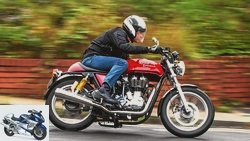
Modern Classic
Royal Enfield Continental GT in the driving report
Progress in chassis and engine technology
read more
Sales prices difficult to justify
From a rational point of view, it is not easy for the Yamaha SR 400 and the Royal Enfield Continental GT to justify their sales prices. For a state-of-the-art, 75 hp MT-07 with ABS, Yamaha only charges 200 euros more than for the SR 400. Of course, only a few SR 400 buyers will opt for an MT-07, but it gives in terms of technology / price ratio a standard that the air-cooled two-valve single-cylinder, which doesn’t even have an electric starter, can hardly live up to.
The bottom line is that only the cult status of the Yamaha SR 400 can help. For a Royal Enfield Continental GT, a prospective customer not only has to bring 6490 euros plus additional costs, but also a good leap of faith in terms of durability. In this point the Enfield has shown itself to be at its best so far. The same motorcycle has historically been used with the BMW HP4 and was not spared by the testers this time either. It has so far put away a considerably high proportion of full load without complaint.
Data and measured values




31 photos
Pictures: Royal Enfield Continental GT and Yamaha SR 400 in the test
To home page
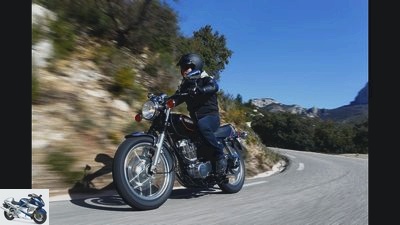
fact
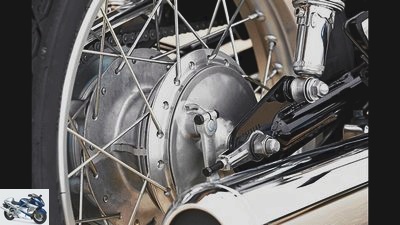
fact
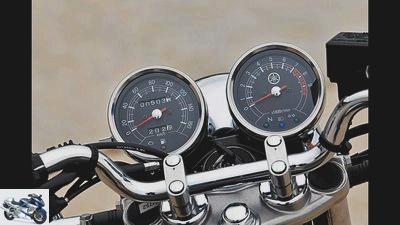
fact
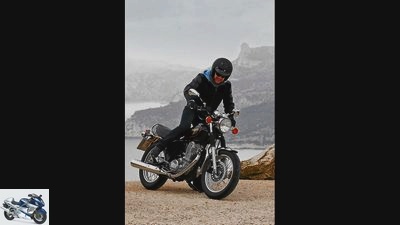
fact
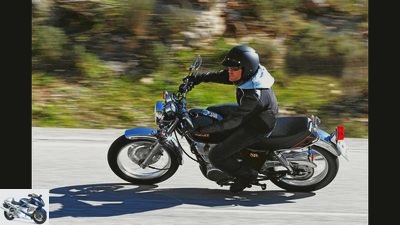
fact
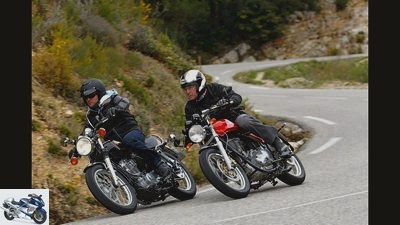
fact
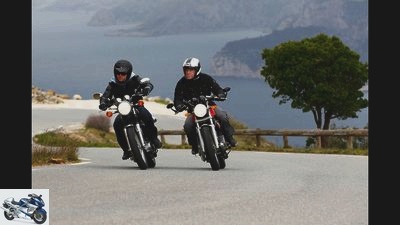
fact
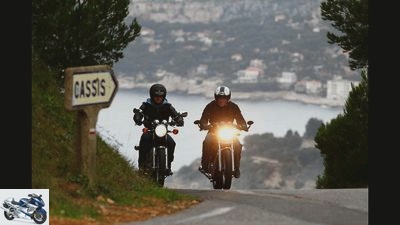
fact
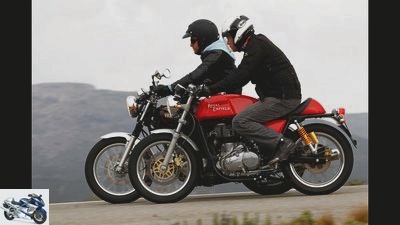
fact
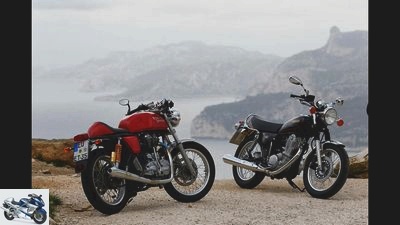
fact
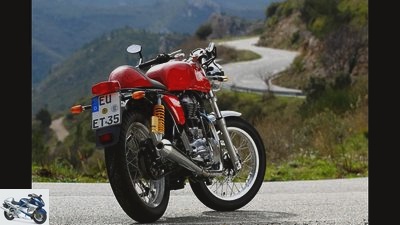
fact

fact
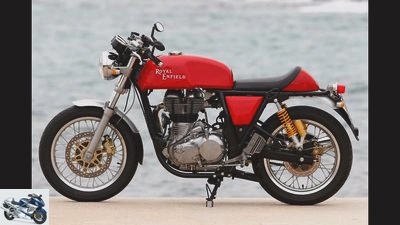
fact
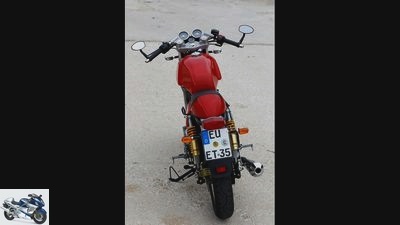
fact
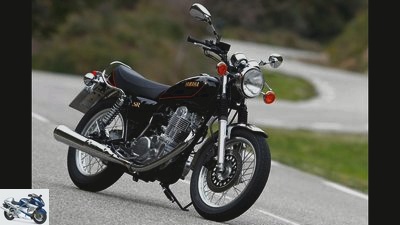
fact
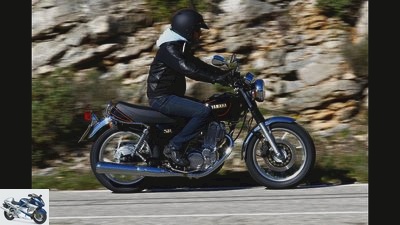
fact
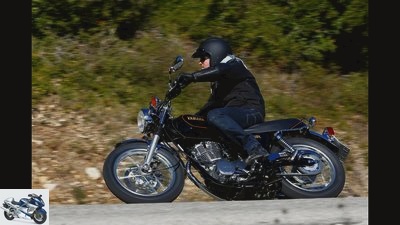
fact
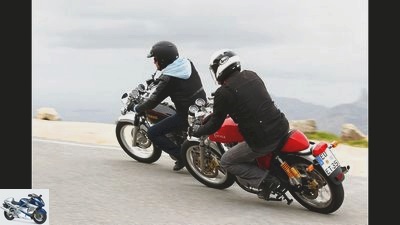
fact

fact
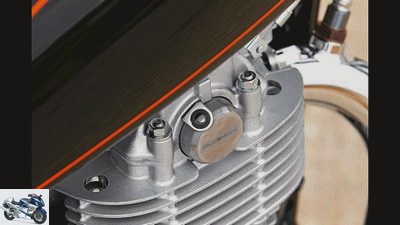
fact
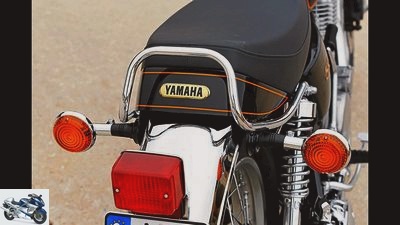
fact
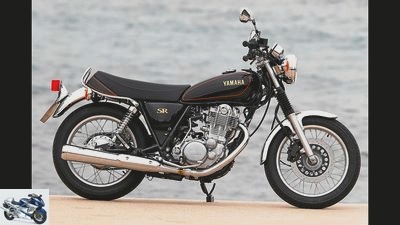
fact
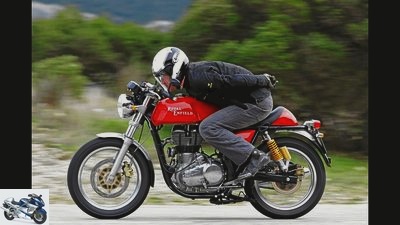
fact
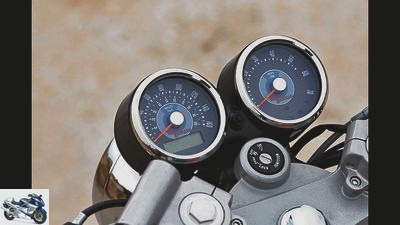
fact
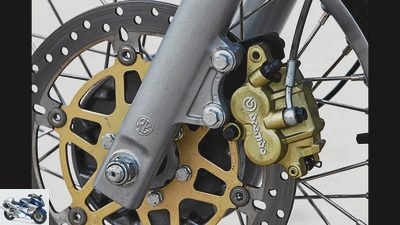
fact
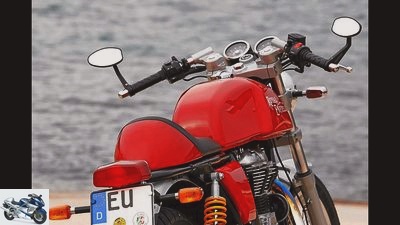
fact
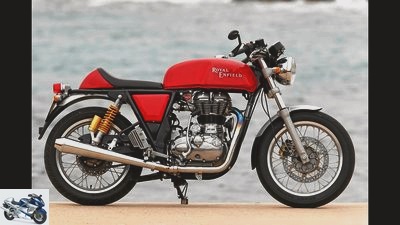
fact
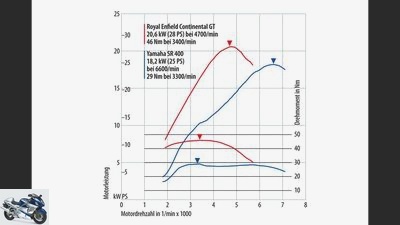
fact
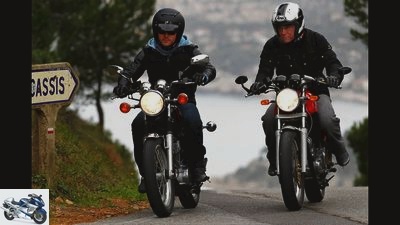
fact
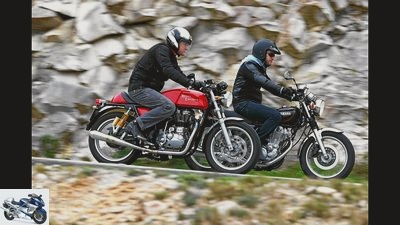
fact
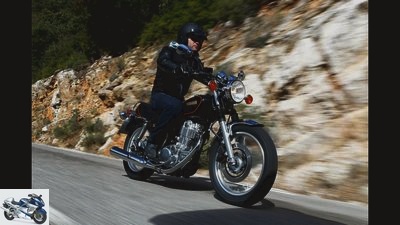
fact
Performance measurement
Power on the crankshaft. Measurements on the Dynojet roller test stand 250, corrected according to 95/1 / EG, maximum possible deviation ± 5%.
These two curves could also illustrate the properties of long and short stroke cylinders in a textbook for engine technology. The Langhuber of the Royal Enfield Continental GT develops its strengths especially at low speeds. After the maximum values, power and torque drop much more sharply with increasing engine speed than with the Yamaha SR 400, which draws a remarkably constant torque curve in the diagram. The absolute values naturally depend more on the displacement than on the stroke; therefore, the 535 Enfield single is in all respects above the 399 Yamaha engine.
MOTORCYCLE conclusion
Royal Enfield Continental GT
The Enfield is the steam hammer of this comparison, a long-stroke bumper single with a lot of pressure from below. The classically styled cafe racer consciously relies on antiquated technology, only delicately modernized. In view of the high price, the processing of the Indian looks rather rustic.
Yamaha SR 400
The SR is authentic, has been built almost unchanged for 35 years and has a dignified finish. With a displacement of 400 cm³ instead of the classic half-liter, the ohc single-cylinder runs very cultivated. The question is whether that will be enough to enforce the demanding sales price on the market.
Related articles
-
Short test Yamaha XVZ 1300 AT Royal Star Tour Classic
Short test Yamaha XVZ 1300 AT Royal Star Tour Classic revamped Front window, chrome all over and leather case under Sissy’s bar at the back – with good …
-
Comparative test BMW K 1200 LT, Harley-Davidson Electra Glide Ultra Classic, Yamaha XVZ 13 TF Royal Star Venture Beautiful living Eating kilometers, for two, …
-
BMW HP4 and Royal Enfield Continental GT
Bilski 47 pictures Bilski 1/47 Bilski 2/47 If necessary, the Royal Enfield could do without a rev counter, … Bilski 3/47 … its double-piston floating caliper, …
-
Kawasaki W 800 Cafe vs. Royal Enfield Continental GT 650
Jorg Kunstle. 23 pictures Jorg Kunstle 1/23 Kawasaki W 800 Cafe and Royal Enfield Continental GT 650 look as if they were straight out of the …
-
Harley-Davidson Sportster 883 Iron and Yamaha XV 950 in the test
Gargolov 34 pictures Gargolov 1/34 Both cruisers aim high. Which bike is more convincing? Gargolov 2/34 The point for the feel-good effect is clear …
-
BMW S 1000 RR and Yamaha YZF-R1 in comparison test
fact 31 pictures fact 1/31 Yamaha YZF-R1. fact 2/31 With both motorcycles, reversing the circuit diagram is a minor matter … fact 3/31 … with the …
-
Royal Enfield Continental GT in the driving report
Royal Enfield 26th photos Enfield 1/26 The driver doesn’t have to crouch on the Continental GT. But when sprinting from cafe to cafe, a sporty stance…
-
Honda CBR 650 F, Suzuki GSX 650 F, Yamaha XJ6 Diversion F in the test
fact 46 pictures fact 1/46 The Suzuki as a solid all-rounder, the Yamaha as a lively fun bike. Honda changed the CB 650 F with the casing …
-
BMW G 310 R and Yamaha MT-03 in the test
25 pictures 1/25 BMW G 310 R and Yamaha MT-03 in the comparison test. 2/25 BMW G 310 R and Yamaha MT-03 in …
-
BMW F 800 R, Kawasaki Z 800, MV Agusta Brutale 800 and Yamaha FZ8 in the test
Jahn 29 pictures Jahn 1/29 A comparison of four 800 class motorcycles: BMW F 800 R, Kawasaki Z 800, MV Agusta Brutale 800 and Yamaha FZ8. Jahn 2/29 How …